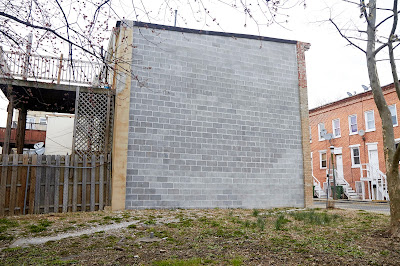 |
| Vacant land in Baltimore, fenced, blighted and ugly |
Vacant land is concerning because it attracts vandalism, provides refuge for drug activity and squatting, and attracts other undesirable behavior. In SafeGrowth we often find vacant lots and empty properties are associated with crime and disorder.
Fortunately, there are ways to transform these liabilities into assets. In our work, we encourage communities to activate vacant land in order to prevent a downward spiral of neighborhood disorder emerging from empty properties. This form of activation is also known as meanwhile spaces.
THE PROBLEM - VACANT LAND
Land vacancy is a prevalent issue especially in formerly highly industrialized cities across North America that are dealing with the consequences of economic downturn. Some of these cities suffer from hypervacancy where 25-50% of properties per census tract have been neglected.
 |
| New York developers restricting access to the river while vacant land sits unused |
We know from 1st Generation CPTED that this is due to poor territoriality or ownership resulting in decreased quality of life. We know from 2nd Generation CPTED that different neighborhoods have different thresholds for tolerating social destabilators (like vacant land), before they tip into social disorder. A timely response to vacancies can halt the slide into disorder.
Some cities have successfully rebuilt former factory buildings into housing. Others, as I've written in prior blogs, transform vacant lots into community gardens and community gathering places. And yet there are many cities that still struggle with vacant land and the consequences of poor upkeep, disorderly conduct, and crime.
Cities across North America and Europe are increasingly activating vacant land – a phenomena sometimes called meanwhile spaces – and temporarily using it to boost the local economy, provide jobs, advocate for social justice, and attract prosocial activities. These include pop-up markets and shops, placemaking, festivals, food trucks, art installations, programs by non-profits and civic collectives, and other activities that benefit the local community.
Meanwhile spaces are a form of tactical urbanism allowing local participation, and they also help developers see what people want in a particular space.
 |
| In Baltimore, there are plans to turn this blank wall into a projector screen for neighborhood movie nights |
In Paris, one place was transformed into a temporary marketplace with diverse, small enterprises. It gave community groups and startups use of a rent-free space rent free until 2020 when the developer intends to commence with the construction.
Another example, from a prior blog, was SafeGrowth advocate Brad Vassallo's description of the pop-up market-place in Philadelphia, a city suffering over 40,000 vacant lots.
In Christchurch, New Zealand, an entire downtown commercial area, destroyed following a devastating earthquake, was transformed into a beautiful shipping-container shopping district. It was a temporary solution that now has wide acceptance and popular appeal (and may become a permanent feature of the city).
 |
| Christchurch NZ shipping container shopping district |
MULTI-FUNCTIONALITY
There are many low-cost and low-risk ways that meanwhile spaces can respond to the needs of residents and their neighborhoods. Creative design strategies can adapt quickly to changing conditions, such as layering multiple activities into one space, thereby injecting life and vibrancy into the local community.
Meanwhile spaces strengthen local relationships, build resilience and provide ownership to spaces that could otherwise attract undesirable activity. They may also signify a shift in modern city planning toward temporary and more responsive use of space.
However, what resonates most with me as a criminologist is the importance of a dedicated local community for transforming vacant spaces from liabilities into assets, thus preventing crime and disorder.
Leave a comment
Please add comments to SafeGrowth. I will post everyone except posts with abusive, off-topic, or offensive language; any discriminatory, racist, sexist or homophopic slurs; thread spamming; or ad hominem attacks.
If your comment does not appear in a day due to blogspot problems send it to safegrowth.office@gmail.com and we'll post direct.